Test Prep GED Test Exam Practice Questions (P. 5)
- Full Access (773 questions)
- Six months of Premium Access
- Access to one million comments
- Seamless ChatGPT Integration
- Ability to download PDF files
- Anki Flashcard files for revision
- No Captcha & No AdSense
- Advanced Exam Configuration
Question #41
Refer to the following diagram:
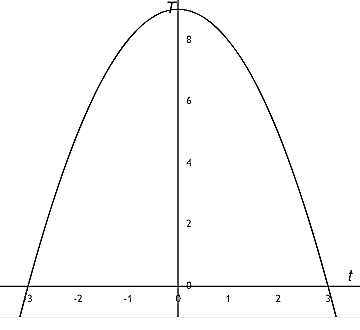
It is necessary to find the times when the temperature is 8ֲ° F. Which of the following is the correct equation to do this?
1. 9 גˆ’ t = 8
2. 9 + t
= 8
3. 9 גˆ’ t
= 8
4. 9t גˆ’ t
= 8

It is necessary to find the times when the temperature is 8ֲ° F. Which of the following is the correct equation to do this?
1. 9 גˆ’ t = 8
2. 9 + t
= 8
3. 9 גˆ’ t
= 8
4. 9t גˆ’ t
= 8
- A1
- B2
- C3
- D4
Correct Answer:
C
It is apparent from the graph that it is not linear hence the answer cannot be 1. If an attempt is made to solve 2 it will be found there is no real solution. One of the solutions to 4 is 8, which gives a negative value. 3 is the only possible solution.
C
It is apparent from the graph that it is not linear hence the answer cannot be 1. If an attempt is made to solve 2 it will be found there is no real solution. One of the solutions to 4 is 8, which gives a negative value. 3 is the only possible solution.
send
light_mode
delete
Question #42
Which of the following is the equation of the straight line joining the points on the graph corresponding to t = 2 and t = 1?
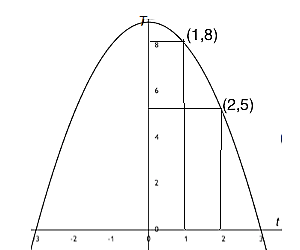

- AT + 3t = 11
- BT גˆ’ 3t = 1
- CT + 11t = 3
- DT + 3t = 1
Correct Answer:
A
The point on the graph corresponding to t = 1 is (1,8).
The point on the graph corresponding to t = 2 is (2,5).
The slope of the straight line joining them is (5 גˆ’ 8) ֳ· (2 גˆ’ 1) = גˆ’3.
The equation is T = גˆ’3t + c -
As (2,5) lies the line we can substitute for t and T.
5 = גˆ’3 ֳ— 2 + c
c = 11
Equation is T = גˆ’3t + 11 which is the same as (A).
A
The point on the graph corresponding to t = 1 is (1,8).
The point on the graph corresponding to t = 2 is (2,5).
The slope of the straight line joining them is (5 גˆ’ 8) ֳ· (2 גˆ’ 1) = גˆ’3.
The equation is T = גˆ’3t + c -
As (2,5) lies the line we can substitute for t and T.
5 = גˆ’3 ֳ— 2 + c
c = 11
Equation is T = גˆ’3t + 11 which is the same as (A).
send
light_mode
delete
Question #43
The following two questions relate to the sphere shown below:
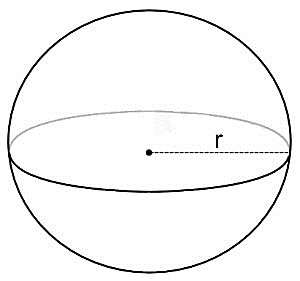
The formula for the volume V of the sphere = 4ֿ€r
/ 3. Which of the following is the closest approximation to the volume when r, the radius, is 11 inches?

The formula for the volume V of the sphere = 4ֿ€r
/ 3. Which of the following is the closest approximation to the volume when r, the radius, is 11 inches?
- A6000 cubic inches
- B5590 cubic inches
- C5573 cubic inches
- D5000 cubic inches
Correct Answer:
C
It is necessary to substitute 11 for r in the formula. The calculation is V = 4/3 ֳ— (ֿ€ = 3.14) ֳ— 113 = 5572.45....... Clearly the closest approximation to this is 5573 cubic inches.
C
It is necessary to substitute 11 for r in the formula. The calculation is V = 4/3 ֳ— (ֿ€ = 3.14) ֳ— 113 = 5572.45....... Clearly the closest approximation to this is 5573 cubic inches.
send
light_mode
delete
Question #44
If the radius of the sphere were doubled by what factor would the surface area be enlarged?
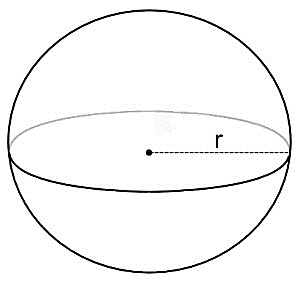
Note: The formula for the surface area S of the sphere = 4 ֳ— ֿ€ ֳ— r

Note: The formula for the surface area S of the sphere = 4 ֳ— ֿ€ ֳ— r
- A2
- B4
- C8
- D16
Correct Answer:
B
If r = 1 then the surface area of the smaller sphere is 12.56...... If the radius is doubled the surface area is 50.26...... The factor is 50.26... ֳ· 12.56.... = 4. The surface area is enlarged by a factor of 4.
B
If r = 1 then the surface area of the smaller sphere is 12.56...... If the radius is doubled the surface area is 50.26...... The factor is 50.26... ֳ· 12.56.... = 4. The surface area is enlarged by a factor of 4.
send
light_mode
delete
Question #45
The graph below is part of the graph of the function T = (t + 1) (t גˆ’ 3) for the temperature in a refrigerator for time t hours after midday.
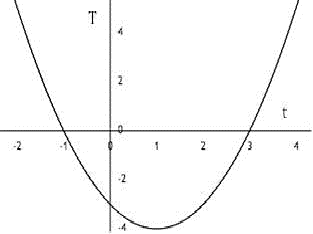
For which set of t values is the temperature below 0?

For which set of t values is the temperature below 0?
- A(1, 3)
- B(גˆ’1, 3)
- Ct ג‰¥ 3
- Dt = 1
Correct Answer:
B
Although T is negative for 1 < t < 3, when t = 3, T = 0.
T ג‰¥ 0 for t ג‰¥ 3 -
T > 0 for t < גˆ’1.
T < 0 or negative when גˆ’1 < t < 3
B
Although T is negative for 1 < t < 3, when t = 3, T = 0.
T ג‰¥ 0 for t ג‰¥ 3 -
T > 0 for t < גˆ’1.
T < 0 or negative when גˆ’1 < t < 3
send
light_mode
delete
Question #46
The picture is a shape created with an equilateral triangle and a square whose area is 36 square inches.
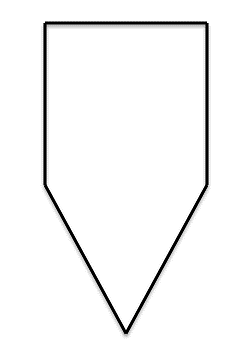
What is the perimeter of the shape?

What is the perimeter of the shape?
- A24 inches
- B30 inches
- C36 inches
- D48 inches
Correct Answer:
B
The three sides of the shape which are sides of the square contribute 18 inches to the perimeter of the shape. The sides which are part of the equilateral triangle are each 6 inches long and contribute 12 inches to the perimeter. The total perimeter is 18 + 12 = 30 inches.
B
The three sides of the shape which are sides of the square contribute 18 inches to the perimeter of the shape. The sides which are part of the equilateral triangle are each 6 inches long and contribute 12 inches to the perimeter. The total perimeter is 18 + 12 = 30 inches.
send
light_mode
delete
Question #47
The picture is a shape created with an equilateral triangle and a square whose area is 36 square inches.
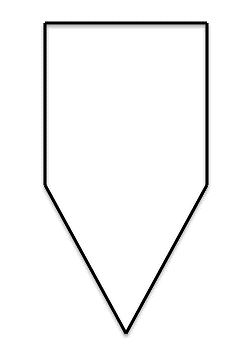
The height of the equilateral triangle is 5.2 inches. Find the area of the shape.

The height of the equilateral triangle is 5.2 inches. Find the area of the shape.
- A54.8 square inches
- B45 square inches
- C51.6 square inches
- D67.2 square inches
Correct Answer:
C
The area of the square is 36 square inches. The area of the equilateral triangle is half base times height = 1/2 ֳ— 6 ֳ— 5.2 = 15.6 square inches. The area of the shape is 36 + 15.6 = 51.6 square inches.
C
The area of the square is 36 square inches. The area of the equilateral triangle is half base times height = 1/2 ֳ— 6 ֳ— 5.2 = 15.6 square inches. The area of the shape is 36 + 15.6 = 51.6 square inches.
send
light_mode
delete
Question #48
In the triangle ABC below, angle B is a right angle.
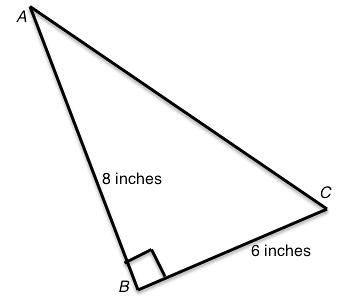
Find the length of AC.

Find the length of AC.
- A10 inches
- B9 inches
- C6.9 inches
- D14 inches
Correct Answer:
A
As ABC is a right angled triangle we can apply the theorem of Pythagoras. The square of the hypotenuse is the sum of the squares of the other two sides. AC
=
+ 6
= 100. AC is 10 inches in length.
A
As ABC is a right angled triangle we can apply the theorem of Pythagoras. The square of the hypotenuse is the sum of the squares of the other two sides. AC
=
+ 6
= 100. AC is 10 inches in length.
send
light_mode
delete
Question #49
Which diagram shows a shape whose volume V can be found by the formula V = r hֿ‰


- A(A)
- B(B)
- C(C)
- D(D)
Correct Answer:
C
Students do not have to know formulas for (A), (B) and (D). The volume of a cylinder is ֿ€r h. This formula is easily obtained by rearranging.
C
Students do not have to know formulas for (A), (B) and (D). The volume of a cylinder is ֿ€r h. This formula is easily obtained by rearranging.
send
light_mode
delete
Question #50
HOTSPOT -
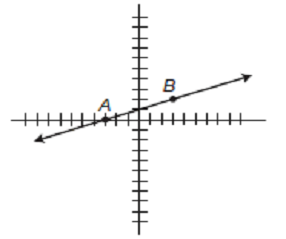
What is the slope of the line that passes through points A and B on the coordinate graph? Mark your answer on the grid below.
Hot Area:
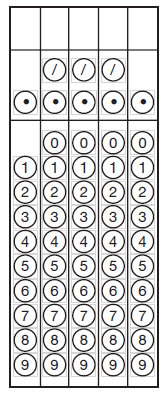

What is the slope of the line that passes through points A and B on the coordinate graph? Mark your answer on the grid below.
Hot Area:

Correct Answer:
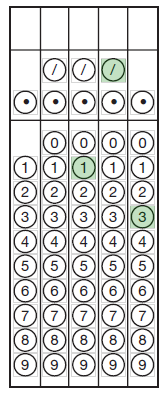
1/3
The coordinates of point A are (גˆ’3,0). The coordinates of point B are (3, 2). Use the slope formula:
(y
גˆ’ y
) / (x
גˆ’ x
)
Substitute and solve:
(2 גˆ’ 0) / (3 גˆ’ (גˆ’3)) = 2/6, or 1/3

1/3
The coordinates of point A are (גˆ’3,0). The coordinates of point B are (3, 2). Use the slope formula:
(y
גˆ’ y
) / (x
גˆ’ x
)
Substitute and solve:
(2 גˆ’ 0) / (3 גˆ’ (גˆ’3)) = 2/6, or 1/3
send
light_mode
delete
All Pages
